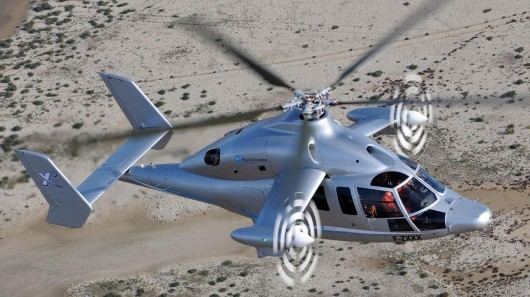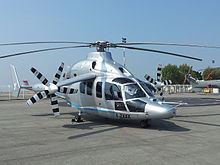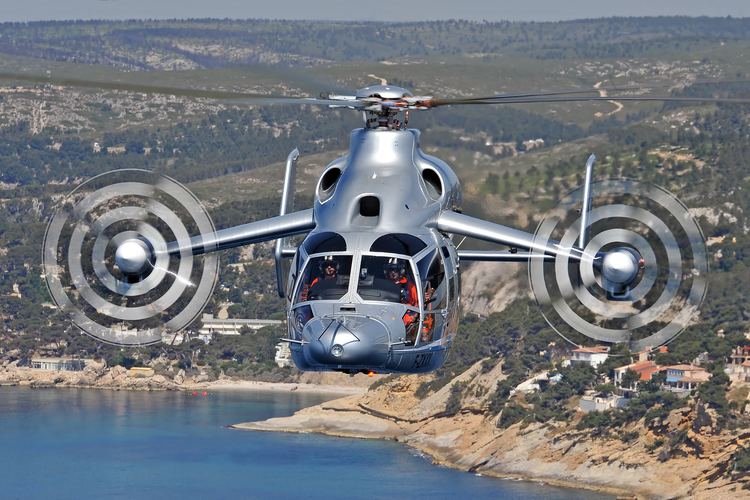Manufacturer Airbus Helicopters | First flight September 6, 2010 | |
 | ||
The Eurocopter X³ (X-Cubed) is an experimental high-speed compound helicopter developed by Eurocopter (now Airbus Helicopters). A technology demonstration platform for Eurocopter "high-speed, long-range hybrid helicopter" or H³ concept, the X³ achieved 255 knots (472 km/h; 293 mph) in level flight on 7 June 2013, setting an unofficial helicopter speed record.
Contents

Technology

The X³ demonstrator is based on the Eurocopter AS365 Dauphin helicopter, with the addition of short span wings each fitted with a tractor propeller, having different pitch to counter the torque effect of the main rotor. Conventional helicopters use tail rotors to counter the torque effect. The tractor propellers are gear driven from the two main turboshaft engines which also drive the five-bladed main rotor system, taken from an Eurocopter EC155.

Guest pilots describe the X³ flight as smooth, but the X³ does not have passive or active anti-vibration systems and can fly without stability augmentation systems, unlike the Sikorsky X2. The helicopter is designed to prove the concept of a high-speed helicopter which depends on slowing the rotor speed (by 15%) to avoid drag from the advancing blade tip, and to avoid retreating blade stall by unloading the rotor while a small wing provides 40–80% lift instead. The X³ can hover with a pitch attitude between minus 10 and plus 15 degrees. Its bank range is 40 degrees in hover, and is capable of flying at bank angles of 120 to 140 degrees. During testing the aircraft demonstrated a rate of climb of 5,500 feet per minute and high-G turn rates of 2Gs at 210 knots.
Performance

The X³ first flew on 6 September 2010 from French Direction générale de l'armement facility at Istres-Le Tubé Air Base.

On 12 May 2011 the X³ demonstrated a speed of 232 knots (267 mph; 430 km/h) while using less than 80 percent of available power.
In May 2012, it was announced that the Eurocopter X³ development team had received the American Helicopter Society's Howard Hughes Award for 2012.
Eurocopter demonstrated the X³ in the United States during the summer of 2012, the aircraft logging 55 flight hours, with a number of commercial and military operators being given the opportunity to fly the aircraft.
With an aerodynamic fairing installed on the rotor head, the X³ demonstrated a speed of 255 knots (293 mph; 472 km/h) in level flight and 263 knots (303 mph; 487 km/h) in a shallow dive on 7 June 2013, beating the Sikorsky X2's unofficial record set in September 2010, and thus becoming the world's fastest non-jet augmented compound helicopter.
Variants
Eurocopter/Airbus Helicopters has suggested that a production H³ application could appear as soon as 2020. The company had also previously expressed an interest in offering an H³ technology based solution for the United States' Future Vertical Lift program, with EADS North America submitting bid to build a technology demonstrator under the US Army's Joint Multi Role (JMR) program, but later withdrew due to cost and because Eurocopter might have to transfer X³ intellectual property to the US, and Eurocopter chose to focus on the Armed Aerial Scout instead. Ultimately the company was not downselected for the JMR effort, and the AAS program was cancelled.
Eurocopter sees the offshore oil market and Search and rescue community as potential customers for X³ technology. An X³-based unpressurised compound helicopter called LifeRCraft is also among the projects planned under the European Union's €4 billion ($5.44 billion) Clean Sky 2 research program as one of two high-speed rotorcraft flight demonstrators. Airbus began development of the hybrid composite helicopter with a 4.6-litre V-8 piston engine in 2014, froze the design in 2016 to start building in 2017, and plans to fly it in 2019.
The X³ was moved to Musée de l’air et de l’espace in 2014 for public display.
Specifications
Data from FlightGlobal; no other specifications have been released by Eurocopter.
General characteristics
Performance
